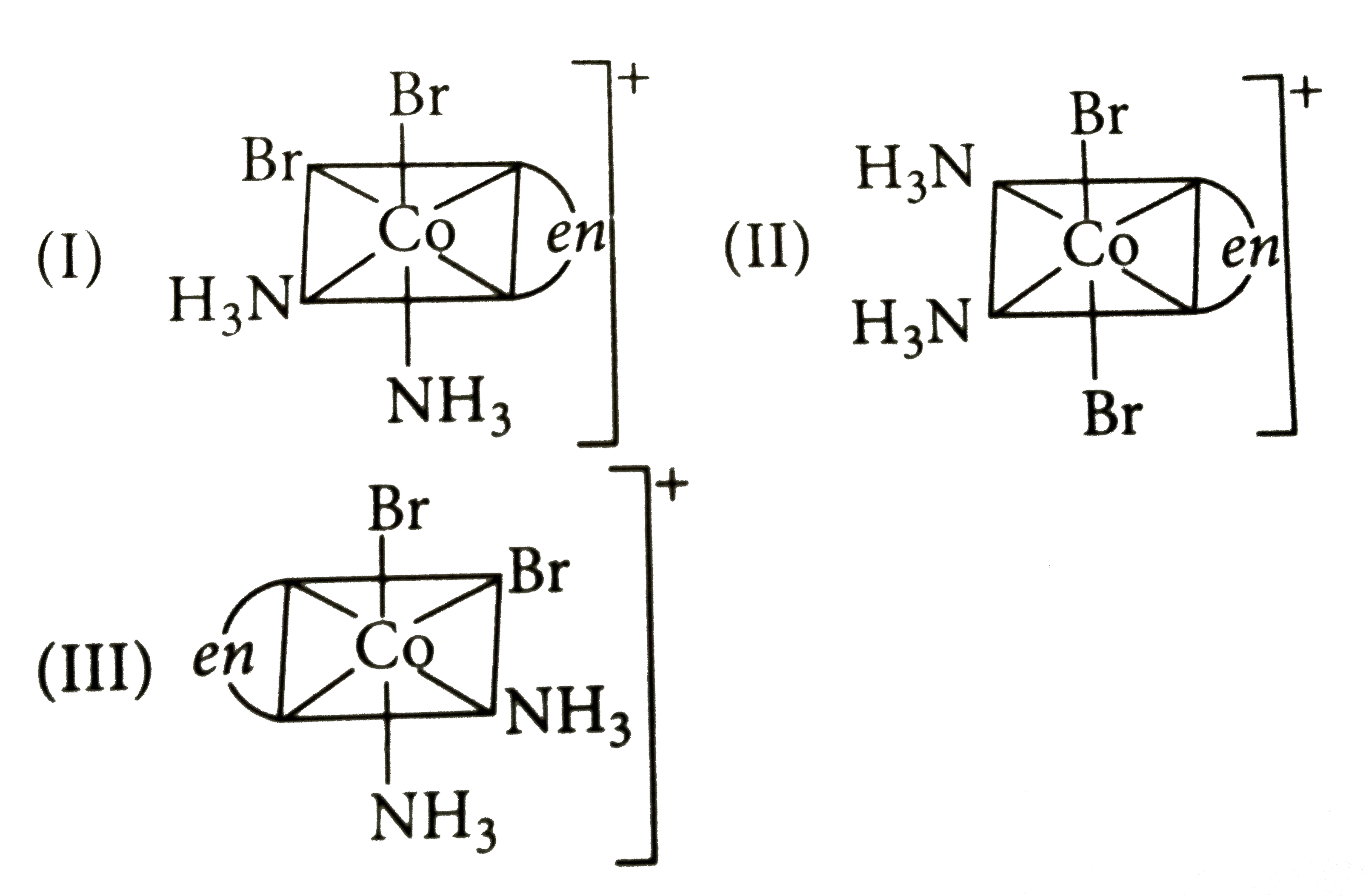[Co(NH3)Cl(en)2]2+ exist which isomerism ?
trans-isomer will show optical isomerism .
cis-isomer will show optical isomerism .
Both trans and cis-isomers will show optical isomerism .
Neither cis nor trans-isomer will show optical isomerism .
The correct Answer is:B
To determine the types of isomerism exhibited by the coordination compound (Co(NH3)Cl(en)2)2+, we will analyze the ligands and their arrangements around the central metal ion, cobalt (Co).
1. Identify the Ligands:
- The complex contains:
- 1 monodentate ligand: Chloride ion (Cl)
- 2 bidentate ligands: Ethylenediamine (en)
- 3 monodentate ligands: Ammonia (NH3)
2. Determine the Coordination Number:
- Cobalt has a coordination number of 6 because it is surrounded by 2 bidentate ligands (each contributing 2 coordination sites) and 1 monodentate ligand (contributing 1 coordination site).
3. Possible Geometries:
- With a coordination number of 6, the geometry of the complex is octahedral.
4. Cis-Trans Isomerism:
- In octahedral complexes, cis and trans isomerism is possible.
- The cis isomer has the two bidentate ligands adjacent to each other, while in the trans isomer, they are opposite each other.
5. Optical Isomerism:
- The cis isomer can exhibit optical isomerism because it lacks a plane of symmetry, allowing for non-superimposable mirror images.
- The trans isomer does not exhibit optical isomerism because it has a plane of symmetry.
6. Conclusion:
- The coordination compound (Co(NH3)Cl(en)2)2+ exhibits:
- Cis-Trans Isomerism: due to the arrangement of the bidentate ligands.
- Optical Isomerism: only in the cis form.
Final Answer:
The coordination compound (Co(NH3)Cl(en)2)2+ exhibits cis-trans isomerism and optical isomerism (only in the cis form).
---
- The complex contains:
- 1 monodentate ligand: Chloride ion (Cl)
- 2 bidentate ligands: Ethylenediamine (en)
- 3 monodentate ligands: Ammonia (NH3)
- Cobalt has a coordination number of 6 because it is surrounded by 2 bidentate ligands (each contributing 2 coordination sites) and 1 monodentate ligand (contributing 1 coordination site).
- With a coordination number of 6, the geometry of the complex is octahedral.
- In octahedral complexes, cis and trans isomerism is possible.
- The cis isomer has the two bidentate ligands adjacent to each other, while in the trans isomer, they are opposite each other.
- The cis isomer can exhibit optical isomerism because it lacks a plane of symmetry, allowing for non-superimposable mirror images.
- The trans isomer does not exhibit optical isomerism because it has a plane of symmetry.
- The coordination compound (Co(NH3)Cl(en)2)2+ exhibits:
- Cis-Trans Isomerism: due to the arrangement of the bidentate ligands.
- Optical Isomerism: only in the cis form.
The coordination compound (Co(NH3)Cl(en)2)2+ exhibits cis-trans isomerism and optical isomerism (only in the cis form).
Topper's Solved these Questions
- BOOK - NCERT FINGERTPS ENGLISHCHAPTER - COORDINATION COMPOUNDS EXERCISE - HOTS8videos
COORDINATION COMPOUNDS
- BOOK - NCERT FINGERTPS ENGLISHCHAPTER - COORDINATION COMPOUNDS EXERCISE - NCERT EXEMPLAR PROBLEMS14videos
COORDINATION COMPOUNDS
- BOOK - NCERT FINGERTPS ENGLISHCHAPTER - CHEMISTRY IN EVERYDAY LIFE EXERCISE - NCERT Exemplar15videos
CHEMISTRY IN EVERYDAY LIFE
- BOOK - NCERT FINGERTPS ENGLISHCHAPTER - ELECTROCHEMISTRYEXERCISE - Assertion And Reason15videos
ELECTROCHEMISTRY
Similar Questions
Knowledge Check
- Question 1 - Select One
Consider the following isomers.
(i) [Pt(NH3)4Cl2]Br2 (ii)[Pt(NH3)4Br2]Cl2
(iii) [Co(NH3)4Cl2]NO2
Which of the following observations is correct ?A(i) will give a part yellow and (ii) will give a white precipitate with AgNO3 solution .B(iii) will give a white precipitate with AgNO3 solution .C(i) , (ii) and (iii) will give white precipitate with AgNO3 solution .DNone of the above isomers will give white precipitate with AgNO3 solution .
Which kind of isomerism is shown by the complex [Co(NH3)5(ONO)]SO4 ?
1. Ionisation isomerism 2.Linkage isomerism
3. Geometrical isomerism 4. Optical isomerism.View SolutionDraw all the isomers (geometrical and optical) of:
(i) [CoCl2(en)2]+
(ii) [Co(NH3)Cl(en)2]2+
(iii) [Co(NH3)2Cl2(en)]+View SolutionWhich of the following complexes can exists as enantiomers ? Draw their structures
(a)cis−[Co(NH3)4Br2]+ (b)cis−[Cr(H2O)2(en)2]3+ (c)[Cr(gly)3]
(d)[Cr(en)3]3+ (e)cis−[Co(NH3)Cl(en)2]2+ (f)trans−[Co(NH3)2(en)2]2+View Solution[Co(NH3)5SO4]Br and [Co(NH3)5Br]SO4 shown _________isomerism .
View SolutionWhich of the following complexes show geometrical as well as optical isomerism ?
(i) [Cr(ox)3]3−
(ii) [Rh(en)2Cl2]+
(iii) [Co(NH3)2Cl2(en)]+
Select the correct codeView Solution[Co(en)2NO2Br]Cl can exhibit
View SolutionDraw the structural isomer of [Co(NH3)5NO2)Cl2 and name the type of isomerism.
View Solution


